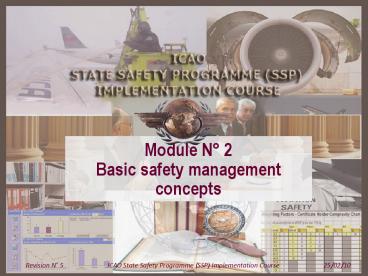ICAO SSP Module 02 - SSP basic safety concepts PowerPoint PPT Presentation
1 / 41
Title: ICAO SSP Module 02 - SSP basic safety concepts
1
(No Transcript)
2
SSP A structured approach
3
Objective
- At the end of this module, participants will be
able to explain the strengths and weaknesses of
long-established approaches to manage safety and
describe new perspectives and methods of managing
safety by the State
4
Contents
- A concept of accident causation
- System performance in the real world
- Safety management strategies Levels of
intervention and tools - Hazards and safety risks
- Safety risk assessment
- Questions and answers
- Points to remember
5
Concept of safety
- Consider (the weaknesses in the notion of
perfection) - The elimination of accidents (and serious
incidents) is unachievable - Failures will occur, in spite of the most
accomplished prevention efforts - No human activity or human-made system can be
guaranteed to be absolutely free from hazard and
operational errors - Controlled safety risk and controlled error are
acceptable in an inherently safe system
6
Concept of safety (Doc 9859)
- Safety is the state in which the possibility of
harm to persons or property damage is reduced to,
and maintained at or below, an acceptable level
through a continuing process of hazard
identification and risk management
7
Safety
8
A concept of accident causation
9
A concept of accident causation
10
A concept of accident causation
Actions or inactions by people (pilots,
controllers, maintenance engineers, aerodrome
staff, etc.) that have an immediate adverse
effect.
11
A concept of accident causation
12
A concept of accident causation
13
System performance in the real world
14
Managing safety Navigating the drift
15
Navigational aids
16
Strategies Levels of intervention and tools
17
Three key definitions
- Hazard Condition or object with the potential
of causing injuries to personnel, damage to
equipment or structures, loss of material, or
reduction of ability to perform a prescribed
function - Consequence Potential outcome(s) of the hazard
- Safety Risk The assessment, expressed in terms
of predicted probability and severity, of the
consequence(s) of a hazard taking as reference
the worst foreseeable situation
18
Three key definitions
- Example
- Unclear aerodrome signage is a hazard
- A runway incursion is one of the consequences of
the hazard - The assessment (quantification) of the
consequences of the potential runway incursion
expressed in terms of probability and severity is
the safety risk
19
Understanding hazards
- There is a natural tendency to describe hazards
as their consequence(s) - Unclear aerodrome signage vs. runway
incursion - Stating a hazard as consequence(s)
- disguises the nature of the hazard
- interferes with identifying other important
consequences - Well-named hazards
- allow to infer the sources or mechanisms of the
hazard - allow to evaluate the loss outcome(s)
20
Types of Hazards
- Natural
- Technical
- Economic
21
Examples of natural hazards
- Severe weather or climatic events
- E.g. hurricanes, major winter storms, drought,
tornadoes, thunderstorms lightning, and wind
shear - Adverse weather conditions
- E.g. Icing, freezing precipitation, heavy rain,
snow, winds, and restrictions to visibility
22
Examples of natural hazards
- Geophysical events
- E.g. earthquakes, volcanic eruptions, tsunamis,
floods and landslides - Geographical conditions
- E.g. adverse terrain or large bodies of water
- Environmental events
- E.g. wildfires, wildlife activity, and insect or
pest infestation - Public health events
- E.g. epidemics of influenza or other diseases
23
Examples of technical hazards
- Deficiencies regarding
- E.g. aircraft and its components, systems,
subsystems and related equipment - E.g. an organizations facilities, tools, and
related equipment - E.g. facilities, systems, sub-systems and
related equipment that are external to the
organization
24
Examples of economic hazards
- Major trends related to
- Growth
- Recession
- Cost of material or equipment
- Etc.
25
Hazard analysis
26
Safety risk management
- What is it?
- The analysis and elimination, and/or mitigation
to an acceptable level of the safety risks of the
consequences of identified hazards - What is the objective?
- A balanced allocation of resources to address all
safety risks and viable safety risks control and
mitigation - Why is it important?
- It is a data-driven approach to safety resources
allocation, thus defensible and easier to explain
27
Definitions
- Probability
- The likelihood that an unsafe event or condition
might occur - Severity
- The possible effects of an unsafe event or
condition, taking as reference the worst
foreseeable situation
28
Safety risk probability
29
Safety risk severity
30
Safety risk assessment matrix (example)
31
Safety risk tolerability
32
Warm-up exercise N 02/01
- Scenario
- Fuel spill on the apron area surface of
approximately 25 m (75 ft) length and 5 m (15 ft)
width, produced by an A310 ready to pushback and
taxi for departure
33
Warm-up exercise N 02/01 results
34
Warm-up exercise N 02/02
- Scenario
- It was observed that airline baggage handling
personnel generates FO(D) on the aerodrome apron
area
35
Warm-up exercise N 02/02 results
36
Questions and answers
- Basic safety management concepts
37
Questions and answers
- Q What is the ICAO definition for safety in Doc
9859? - A ?
Slide number
38
Questions and answers
- Q Explain the three different methods for
navigating the drift - A
Slide number
39
Questions and answers
- Q Define safety risk management
- A ?
Slide number
40
Points to remember
- The concept of safety
- Systems and operational performance in the real
world - Levels of intervention and tools for managing
safety - Hazard identification
- Safety risk management
41
Module N 2 Basic safety management concepts

